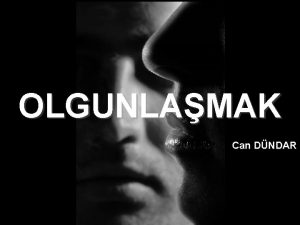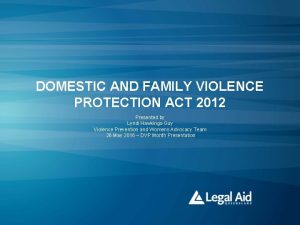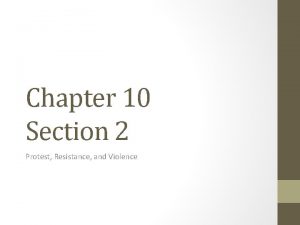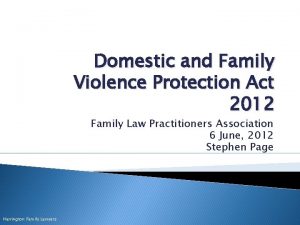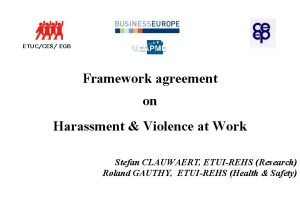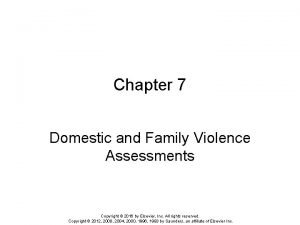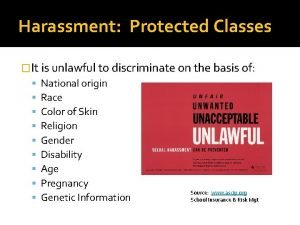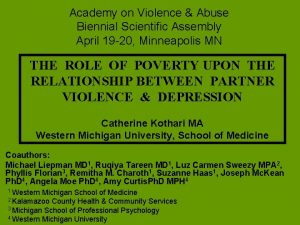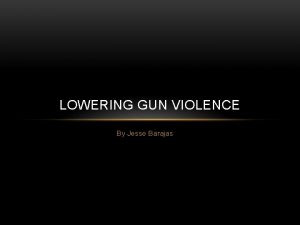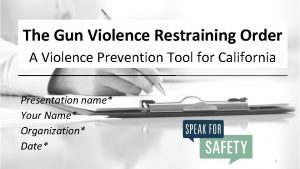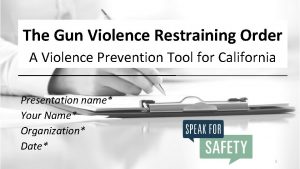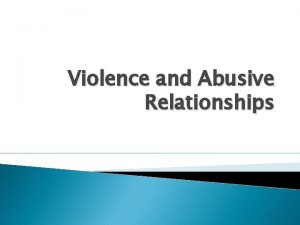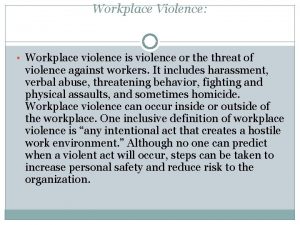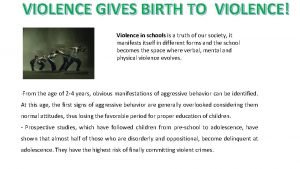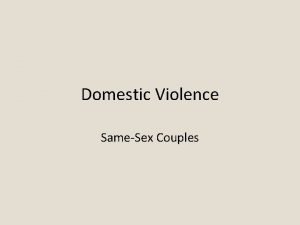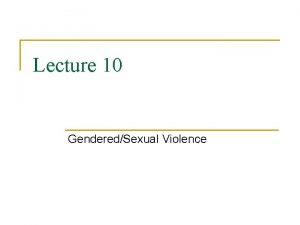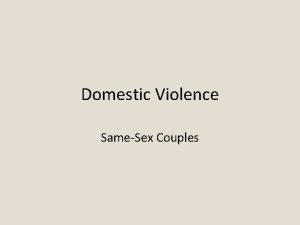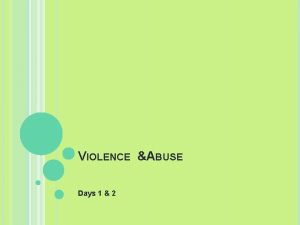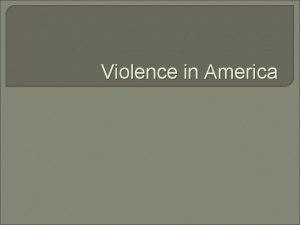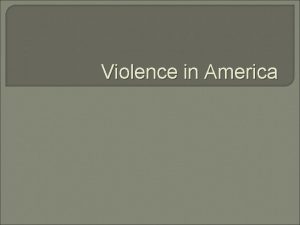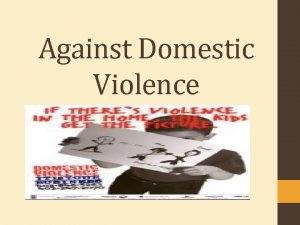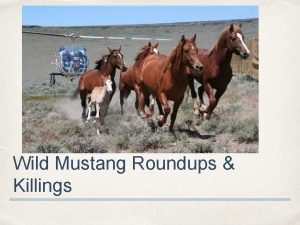Perspectives on Gun Violence and Mass Killings GUN

















![J Appl Psychol. 2015 Jun 29. [Epub ahead of print] Catching Rudeness Is Like J Appl Psychol. 2015 Jun 29. [Epub ahead of print] Catching Rudeness Is Like](https://slidetodoc.com/presentation_image_h2/256c22a8fb66e40af2c963a48e5de234/image-18.jpg)







- Slides: 25

Perspectives on Gun Violence and Mass Killings


GUN VIOLENCE ARCHIVE 2014 TOLL OF GUN VIOLENCE 51, 762 • Number of Deaths 12, 569 • Number of Injuries 23, 020 • Total Number of Incidents 1 1 • Number of Children (age 0 -11) Killed/Injured 1 628 • Number of Teens (age 12 -17) Killed/Injured 1 2, 373 • Mass Shooting 2 281 • Officer Involved Incident 2 3, 214 • Home Invasion 2 2, 606 • Defensive Use 2 1, 585 • Accidental Shooting 2 1, 601 Gun violence incidents collected/validated from 1200+ sources daily – source links on each incident report. 1: Actual number of deaths and injuries 2: Number of INCIDENTS reported and verified Numbers on this table reflect a subset of all information collected and will not add to 100% of incidents. www. gunviolencearchive. org www. facebook. com/gunviolencearchive Data Validated: November 25, 2015







RUNNING AMOK • "Running amok" is used to refer to the behavior of someone who, in the grip of strong emotion, obtains a weapon and begins attacking people indiscriminately, often with multiple fatalities. [13] An episode of amok may be triggered by a period of depression or highly aggressive behavior. The slang terms going postal or going ballistic are similar in scope. Police describe such an event as a killing spree. If the individual is seeking death an alternate method is often "suicide by cop". • Amok is often described as a culture-bound (or culture-specific) syndrome, [14][15] which is a psychological condition whose manifestation is strongly shaped by cultural factors. Other reported culture-bound syndromes are latah and koro. Amok is also sometimes considered one of the subcategories of dissociative disorders (cross-cultural variant).

Berserkers


Clinical aspects • • Underlying problem (e. g. paranoia, anger, etc. ) Access to weapons Opportunity (proximity) Isolation Few interpersonal relations (esp. with women) Prone to fantasy (esp. video games) Stress/in general, but precipitating factors, such as job loss, school failure, etc.

Additional factors • Weird (different) • Crazy • Mean

MEAN WEIRD CRAZY

WEIRD MEAN CRAZY

Models • Mental illness (individual)—National Rifle Association • Historic context—record of gun violence, etc in slavery, extermination, genocide • Role of fantasy (violent video games, TV) • Community intervention
![J Appl Psychol 2015 Jun 29 Epub ahead of print Catching Rudeness Is Like J Appl Psychol. 2015 Jun 29. [Epub ahead of print] Catching Rudeness Is Like](https://slidetodoc.com/presentation_image_h2/256c22a8fb66e40af2c963a48e5de234/image-18.jpg)
J Appl Psychol. 2015 Jun 29. [Epub ahead of print] Catching Rudeness Is Like Catching a Cold: The Contagion Effects of Low-Intensity Negative Behaviors. Foulk T, Woolum A, Erez A. Abstract In this article we offer a new perspective to the study of negative behavioral contagion in organizations. In 3 studies, we investigate the contagion effect of rudeness and the cognitive mechanism that explains this effect. Study 1 results show that low-intensity negative behaviors like rudeness can be contagious, and that this contagion effect can occur based on single episodes, that anybody can be a carrier, and that this contagion effect has secondorder consequences for future interaction partners. In Studies 2 and 3 we explore in the laboratory the cognitive mechanism that





“I say we had best look our times searchingly in the face, like a physician diagnosing some deep disease. ”– Walt Whitman, Democratic Vistas, 1871


 Austin goss
Austin goss Killings dubus
Killings dubus True himmler david irving
True himmler david irving Coil gun
Coil gun Coil vs rail gun
Coil vs rail gun Kötü gün sözleri
Kötü gün sözleri Relative formula mass of hcl
Relative formula mass of hcl Differentiate between atomic number and mass number
Differentiate between atomic number and mass number How to calculate abundance of isotopes
How to calculate abundance of isotopes Magnesium atomic number
Magnesium atomic number Identify the remaining modifiers of human act.
Identify the remaining modifiers of human act. Domestic and family violence protection act 2012
Domestic and family violence protection act 2012 Gandhi king and mandela what made non-violence work dbq
Gandhi king and mandela what made non-violence work dbq Chapter 9 resolving conflicts and preventing violence
Chapter 9 resolving conflicts and preventing violence Chapter 27 anger aggression and violence
Chapter 27 anger aggression and violence Chapter 10 section 2 protest resistance and violence
Chapter 10 section 2 protest resistance and violence S68r family law act
S68r family law act Chapter 9 resolving conflicts and preventing violence
Chapter 9 resolving conflicts and preventing violence Chapter 10 section 2 protest resistance and violence
Chapter 10 section 2 protest resistance and violence Framework agreement on harassment and violence at work
Framework agreement on harassment and violence at work Chapter 7 domestic and family violence assessment
Chapter 7 domestic and family violence assessment Workplace violence and harassment quiz answers
Workplace violence and harassment quiz answers Chapter 10 section 2 protest resistance and violence
Chapter 10 section 2 protest resistance and violence Academy on violence and abuse
Academy on violence and abuse Social action theorists
Social action theorists Professional nursing practice 7th edition
Professional nursing practice 7th edition





